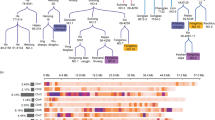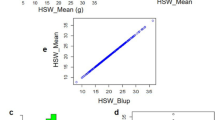Abstract
Increasing the oil concentration in soybean seeds has been given more attention in recent years because of demand for both edible oil and biodiesel production. Oil concentration in soybean is a complex quantitative trait regulated by many genes as well as environmental conditions. To identify genes governing seed oil concentration in soybean, 16 putative candidate genes of three important gene families (GPAT: acyl-CoA:sn-glycerol-3-phosphate acyltransferase, DGAT: acyl-CoA:diacylglycerol acyltransferase, and PDAT: phospholipid:diacylglycerol acyltransferase) involved in triacylglycerol (TAG) biosynthesis pathways were selected and their sequences retrieved from the soybean database (http://www.phytozome.net/soybean). Three sequence mutations were discovered in either coding or noncoding regions of three DGAT soybean isoforms when comparing the parents of a 203 recombinant inbreed line (RIL) population; OAC Wallace and OAC Glencoe. The RIL population was used to study the effects of these mutations on seed oil concentration and other important agronomic and seed composition traits, including seed yield and protein concentration across three field locations in Ontario, Canada, in 2009 and 2010. An insertion/deletion (indel) mutation in the GmDGAT2B gene in OAC Wallace was significantly associated with reduced seed oil concentration across three environments and reduced seed yield at Woodstock in 2010. A mutation in the 3′ untranslated (3′UTR) region of GmDGAT2C was associated with seed yield at Woodstock in 2009. A mutation in the intronic region of GmDGAR1B was associated with seed yield and protein concentration at Ottawa in 2010. The genes identified in this study had minor effects on either seed yield or oil concentration, which was in agreement with the quantitative nature of the traits. However, the novel gene-specific markers designed in the present study can be used in soybean breeding for marker-assisted selection aimed at increasing seed yield and oil concentration with no significant impact on seed protein concentration.












Similar content being viewed by others
References
Arslanoglu F, Aytac S, Oner EK (2011) Effect of genotype and environment interaction on oil and protein content of soybean (Glycine max (L.) Merrill) seed. Afr J Biotechnol 10(80):18409–18417
Bailey-Serres J, Dawe RK (1996) Both 5′ and 3′Sequences of Maize adh7 mRNA are required for enhanced translation under low-oxygen conditions. Plant Physiol 11(2):685–695
Beisson F, Koo AJK, Ruuska S, Schwender J, Pollard M, Thelen JJ, Paddock T, Salas JJ, Savage L, Milcamps A et al (2003) Arabidopsis genes involved in acyl lipid metabolism: a 2003 census of the candidates, a study of the distribution of expressed sequence tags in organs, and a Web-based database. Plant Physiol 132:681–697
Bourdon V, Harvey A, Lonsdale DM (2001) Introns and their positions affect the translational activity of mRNA in plant cells. EMBO Rep 2:394–398
Bouvier-Nave P, Benveniste P, Oelkers P, Sturley SL, Schaller H (2000) Expression in yeast and tobacco of plant cDNAs encoding acyl CoA:diacylglycerol acyltransferase. Eur J Biochem 267:85–96
Browse J, Somerville C (1991) Glycerolipid metabolism, biochemistry and regulation. Annu Rev Plant Physiol Plant Mol Biol 42:467–506
Burgal J, Shockey J, Lu CF, Dyer J, Larson T, Graham I, Browse J (2008) Metabolic engineering of hydroxy fatty acid production in plants: RcDGAT2 drives dramatic increases in ricinoleate levels in seed oil. Plant Biotechnol J 6:819–831
Dahlqvist A, Stahl U, Lenman M, Banas A, Lee M, Sandager L, Ronne H, Stymne S (2000) Phospholipid:diacylglycerol acyltransferase: an enzyme that catalyzes the acyl-CoA independent formation of triacylglycerol in yeast and plants. Proc Natl Acad Sci USA 97:6487–6492
Eskandari M, Cober ER, Rajcan I (2013a) Genetic control of soybean seed oil: I. QTL and genes associated with seed oil concentration in RIL populations derived from crossing moderately high oil parents. Theor Appl Genet 126:483–495
Eskandari M, Cober ER, Rajcan I (2013b) Genetic control of soybean seed oil: II. QTL and genes that increase oil concentration without decreasing protein or with increased yield. Theor Appl Genet. doi:10.1007/s00122-013-2083-z
Floris M, Mahgoub H, Lanet E, Robaglia C, Menand C (2009) Post-transcriptional regulation of gene expression in plants during abiotic stress. Int J Mol Sci 10:3168–3185
Gurdeep S, Dhillon SK, Gill BS, Sunita S (2001) Stability analysis for seed yield and quality characters in soybean (Glycine max (L). Merrill). Crop Improv 28(2):244–248
Harwood JL (1996) Recent advances in the biosynthesis of plant fatty acids. Biochim Biophys Acta 1301:7–56
Hildebrand DF, Li R, Hatanaka T (2008) Genomics of Soybean Oil Traits. In: Stacey G (ed) Genetics and genomics of soybean 12: 185–209
Holland JB (1998) EPISTACY: a SAS program for detecting two locus epistatic interactions using genetic marker information. J Hered 89:374–375
Jain RK, Coffey M, Lai K, Kumar A, MacKenzie SL (2000) Enhancement of seed oil content by expression of glycerol-3-phosphate acyltransferase genes. Biochem Soc Trans 28:958–961
Jako C, Kumar A, Wei YD, Zou JT, Barton DL, Giblin EM, Covello PS, Taylor DC (2001) Seed-specific over-expression of an Arabidopsis cDNA encoding a diacylglycerol acyltransferase enhances seed oil content and seed weight. Plant Physiol 126:861–874
Kim E, Magen A, Ast G (2006) Different levels of alternative splicing among eukaryotes. Nucleic Acids Res 35:125–131
Kudla G, Murray AW, Tollervey D, Plotkin JB (2009) Coding sequence determinants of gene expression in Escherichia coli. Science 324:255–258
Lardizabal K, Effertz R, Levering C, Mai J, Pedroso MC, Jury T, Aasen E, Gruys K, Bennett K (2008) Expression of Umbelopsis ramanniana DGAT2A in seed increases oil in soybean. Plant Physiol 148:89–96
Li R, Yu K, Hildebrand DF (2010) DGAT1, DGAT2 and PDAT expression in seeds and other tissues of epoxy and hydroxy fatty acid accumulating plants. Lipids 45:145–157
Lock YY, Snyder CL, Zhu WM, Siloto RMP, Weselake RJ, Shah S (2009) Antisense suppression of type 1 diacylglycerol acyltransferase adversely affects plant development in Brassica napus. Physiol Plant 137:61–71
Merritt C, Rasoloson D, Ko D, Seydoux G (2008) 3′UTRs Are the Primary Regulators of Gene Expression in the C. elegans Germline. Curr Biol 18:1476–1482
Mhaske V, Beldjilali K, Ohlrogge JB, Pollard M (2005) Isolation and characterization of an Arabidopsis thaliana knockout line for phospholipid: diacylglycerol transacylase gene (At5g13640). Plant Physiol Biochem 43:413–417
Nozaki T, Cross GA (1995) Effects of 3′ untranslated and intergenic regions on gene expression in Trypanosoma cruzi. Mol Biochem Parasitol 75:55–67
Oakes J, Brackenridge D, Colletti R, Daley M, Hawkins DJ, Xiong H et al (2011) Expression of fungal diacylglycerol acyltransferase2 genes to increase kernel oil in maize. Plant Physiol 155:146–157
Ohlrogge J, Browse J (1995) Lipid biosynthesis. Plant Cell 7:957–970
OOPSCC (2013) Ontario oil and protein seed crop committee. http://www.oopscc.org/index.php, reports 2000, 2001, and 2010 (Online)
Paran I, Zamir D (2003) Quantitative traits in plants: beyond the QTL. Trends Genet 19:303–306
Schlueter JA, Dixon P, Granger C, Grant D, Clark L, Doyle JJ, Shoemaker RC (2004) Mining EST databases to resolve evolutionary events in major crop species. Genome 47:868–876
Schlueter JA, Lin JY, Schlueter SD, Vasylenko-Sanders IF, Deshpande S, Yi J, O’Bleness M, Roe BA, Nelson RT, Scheffler BE et al (2007) Gene duplication and paleopolyploidy in soybean and the implications for whole genome sequencing. BMC Genomics 8:330
Schmutz J et al (2010) Genome sequence of the palaeopolyploid soybean. Nature 463:178–183
Shockey JM, Gidda SK, Chapital DC, Kuan JC, Dhanoa PK, Bland JM, Rothstein SJ, Mullen RT, Dyer JM (2006) Tung tree DGAT1 and DGAT2 have nonredundant functions in triacylglycerol biosynthesis and are localized to different subdomains of the endoplasmic reticulum. Plant Cell 18:2294–2313
Song QJ, Marek LF, Shoemaker RC, Lark KG, Concibido VC, Delannay X, Specht JE, Cregan PB (2004) A new integrated genetic linkage map of the soybean. Theor Appl Genet 109:122–128
Sudaric A, Simic D, Vrataric M (2006) Characterization of genotype by environment interactions in soybean breeding programmer of Southeast Europe. Plant Breed 125:191–194
Taylor DC, Zhang Y, Kumar A, Francis T et al (2009) Molecular modification of triacylglycerol accumulation by over-expression of DGAT1 to produce canola with increased seed oil content under field conditions. Botany 87:533–543
Thiel T, Kota R, Grosse I, Stein N, Graner A (2004) SNP2CAPS: a SNP and INDEL analysis tool for CAPS marker development. Nucl Acids Res 32:5e–5
Untergasser A, Nijveen H, Rao X, Bisseling T, Geurts R, Leunissen JAM (2007) Primer3Plus, an enhanced web interface to Primer3. Nucleic Acids Res 35:W71–W74
Vigeolas H, Geigenberger P (2004) Increased levels of glycerol-3-phosphate leading to a stimulation of flux into triacylglycerol synthesis after supplying glycerol to developing seeds of Brassica napus L. in planta. Planta 219:827–835
Wang HW, Zhang B, Hao YJ, Huang J, Tian AG, Liao Y, Zhang JS, Chen SY (2007) The soybean Dof-type transcription factor genes, GmDof4 and GmDof11, enhance lipid content in the seeds of transgenic Arabidopsis plants. Plant J 52:716–729
Weselake RJ, Shah S, Tang M et al (2008) Metabolic control analysis is helpful for informed genetic manipulation of oilseed rape (Brassica napus) to increase seed oil content. J Exp Bot 59:3543–3549
Weselake RJ, Taylor DC, Rahman MH, Shah S, Laroche A, McVetty PB, Harwood JL (2009) Increasing the flow of carbon into seed oil. Biotechnol Adv 27:866–878
Xu Y, Crouch JH (2008) Marker-assisted selection in plant breeding: from publications to practice. Crop Sci 48:391–407
Zheng P, Allen WB, Roesler K, Williams ME, Zhang S, Li J, Glassman K, Ranch J, Nubel D, Solawetz W et al (2008) A phenylalanine in DGAT is a key determinant of oil content and composition in maize. Nat Genet 40:367–372
Acknowledgments
The authors would like to thank Drs G. R. Ablett (in memoriam), K. P. Pauls, L. R. Erikson, and Y. Kakuda (University of Guelph) for their valuable suggestions on this research. The authors are also grateful to Wade Montminy, Chris Grainger, Ron Guillemette, Bryan Stirling, Dennis Fischer and the entire soybean crew at the University of Guelph for their excellent technical support. Generous funding to conduct this research was provided by the Alternative Renewable Fuels II Program of the Ontario Ministry of Agriculture, Food and Rural Affairs (OMAFRA) and by the Grain Farmers of Ontario.
Author information
Authors and Affiliations
Corresponding author
Additional information
Communicated by D. Lightfoot.
Electronic supplementary material
Below is the link to the electronic supplementary material.
Rights and permissions
About this article
Cite this article
Eskandari, M., Cober, E.R. & Rajcan, I. Using the candidate gene approach for detecting genes underlying seed oil concentration and yield in soybean. Theor Appl Genet 126, 1839–1850 (2013). https://doi.org/10.1007/s00122-013-2096-7
Received:
Accepted:
Published:
Issue Date:
DOI: https://doi.org/10.1007/s00122-013-2096-7




